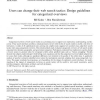284 search results - page 12 / 57 » Evolving interface design for robot search tasks |
118
Voted
ECAL
2007
Springer
15 years 5 months ago
2007
Springer
In this paper we describe a model in which artificial evolution is employed to design neural mechanisms that control the motion of two autonomous robots required to communicate th...
101
click to vote
CIKM
2009
Springer
15 years 4 months ago
2009
Springer
This paper describes a hidden Markov model (HMM) based approach to perform search interface segmentation. Automatic processing of an interface is a must to access the invisible co...
105
click to vote
CHI
2007
ACM
16 years 2 days ago
2007
ACM
As open source development has evolved, differentiation of roles and increased sophistication of collaborative processes has occurred. Recently, we described coordination issues i...
109
click to vote
CIG
2005
IEEE
15 years 5 months ago
2005
IEEE
Several attempts have been made in the past to construct encoding schemes that allow modularity to emerge in evolving systems, but success is limited. We believe that in order to c...
IPM
2008
14 years 11 months ago
2008
Categorized overviews of web search results are a promising way to support user exploration, understanding, and discovery. These search interfaces combine a metadata-based overvie...


